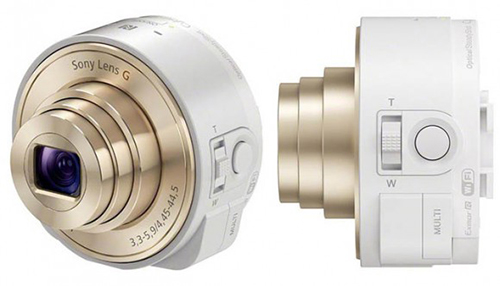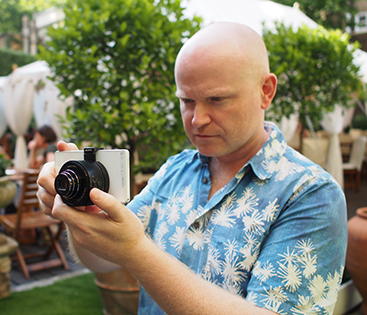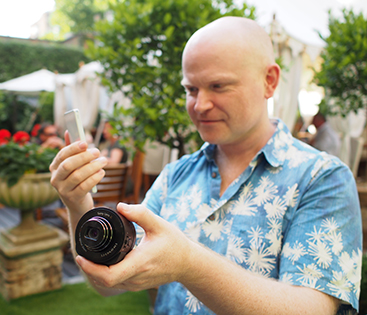Sony QX10
-
-
Written by Gordon Laing
The Sony QX10 is a new type of digital camera called a Smart Lens, designed to enhance the photographic capabilities of your iOS or Android smartphone. A Smart Lens contains the sensor and optically stabilized zoom lens of an existing Sony camera, squeezed into a small cylinder like a sawn-off canned drink. They also feature their own battery and Micro SD slot, and communicate with your phone using Wifi – with NFC to simplify negotiation on compatible handsets – so you simply use the screen on your phone to compose and control the camera. So rather than Smart Lens, you could alternatively think of them as screen-less cameras.
Sony supplies each Smart Lens with a bracket for gripping onto handsets measuring between 54 and 75mm wide and up to 13mm thick, but it’s possible to detach the Smart Lens from the bracket and use it as far away as the Wifi signal will reach; they also have their own tripod threads. This means you can not only use Smart Lenses with larger tablets, like iPads or larger NEXUS devices, but also position them at unusual angles or for self portraits while you effectively remote control them with the mobile.
Sony launched its Smart Lens series in September 2013 with two models. The QX10, previewed here, is based on the 18 Megapixel / 1/2.3in sensor and 10x optical zoom of the Cyber-shot WX150 / WX200, while the higher-end QX100 is based on the 20 Megapixel / 1in sensor and 3.6x zoom of the Cyber-shot RX100 II. Indeed the QX10 and QX100 are essentially screenless versions of the WX150 / WX200 and RX100 II, housed in different bodies. At a Sony press event, I got to try both Smart Lenses and got to see how they work in practice – read on for my hands-on preview.
 |
Sony Cyber-shot QX10 hands-on preview
Sony’s reasoning for Smart Lenses is driven by the fact an increasing number of people are taking and sharing photos with their smartphones, but are dissatisfied by their image quality and lack of optical zoom, not to mention absence of stabilisation. The Smart Lenses certainly resolve this by bypassing the existing built-in camera and using their own sensor and optics instead – indeed they even use their own storage and power, so about the only part of your phone that they do use is the screen.
Even the software is different. Rather than trying to supply images to the default camera app, the Sony Smart Lenses are designed to work with a newly upgraded version of Sony’s Play Memories app, which offers full control of the settings, shutter and zoom. Interestingly though the Smart Lenses also feature their own shutter release and zoom controls, so you don’t even need to use the phone for those either. As I mentioned above, they don’t even need to be physically attached to the phone to work – they really are almost entirely independent digital cameras, only without any screens and equipped with basic controls.
In the flesh, the QX10 is a satisfyingly squat cylindrical shape, and like most of Sony’s gadgets, looks and feels good in your hands. I was initially concerned by screen and shutter lag over the Wifi link, but keeping the lens and phone within a couple of meters of each other kept them feeling responsive.
 |
 | |
At 63mm in diameter and 33mm thick, the QX10 is almost half the thickness of the QX100, making it much more pocketable. The sensor is a little larger than that in most smartphones, delivering better quality, but the major difference here is the 10x optical zoom with stabilisation, allowing you to get much closer to distant subjects without the compromises of digital zooms.
Like the QX100 though, there are some restrictions to be aware of. First of all, while the Play Memories app offers Aperture Priority on the QX100, the QX10 remains pretty much automatic, but to be fair the actual camera it’s based on didn’t offer any further control either. Like the QX100 there’s no Sweep Panorama, although at least the quoted battery life for the QX10 is the same as the WX150 / WX200 at 220 shots. Oh and like the QX100, there’s no room for a built-in flash.
So the only real compromises between the QX10 and WX150 / WX200 are the absence of Sweep Panorama and a built-in flash. For me this, coupled with the smaller size, actually makes it the preferable model of the two Smart Lenses, even if there’s only a minor price saving between the QX10 and the model it’s based on. Meanwhile the higher-end QX100 may be based on the highly desirable RX100 II compact and priced comfortably lower, but lacks its RAW mode, manual exposures, Sweep Panorama, suffers from one third less battery life and is too thick to comfortably squeeze into a pocket.
So while I think the QX100 will attract many people to the Smart Lens concept, a little more research will either convince them the QX10 is the more practical option, or that the camera they really want is the RX100 II. Speaking of which, if you want to know more about the RX100 II and its quality, check out my in-depth Sony RX100 II review!
Returning to the QX10, it’ll improve the image quality of your phone and massively improve its telephoto reach and stabilisation for $250 USD / 179 GBP. Unlike the QX100 it’s priced at a much more affordable level where you may forgive many foibles, and again it’s much more pocketable too. For me it’s the better of the two models, but as always I’d love to hear what you think – let me know on Twitter, Facebook and G+!




